Past meets present: Actraiser Renaissance
ActRaiser is one of the greats, and its recent remaster does it justice while adding in a whole bunch of new wrinkles that are (mostly) in the spirit of the original.
This column is “Past meets present,” the aim of which is to look back at game franchises and games that are in the news and topical again thanks to a sequel, a remaster, a re-release, and so on. Previous entries in this series can be found through this link.
The original ActRaiser is not a game that everyone has played, but, like with essentially everything the now-defunct Quintet developed for the Super Nintendo, everyone should. Published by Enix and released in December of 1990 in Japan — less than a month after the release of the Super Famicom there — ActRaiser helped display the kind of promise that the successor to the Famicom/NES held. Not only did it feature some detailed background art and impressive effects in its sidescrolling levels, but its god-sim elements utilized an early example of Mode 7 in SNES games, and the soundtrack went beyond the basic capabilities of the hardware itself to show off just what could be done by programmers and composers who took the time to finesse their sound.
And yet, the game just didn’t take off commercially. It managed 620,000 worldwide sales, which is fine enough when you consider there were only so many SNES systems purchased in those early days, but it didn’t have a particularly long tail that kept it moving off of shelves even as the system’s popularity increased. North America and Europe were far less interested in the game than Japan, with the latter accounting for 400,000 of the total sales of the game despite having fewer systems sold than North America alone, never mind North America and Europe combined.
Critically, though, ActRaiser was and is beloved. Its availability on the Wii Virtual Console in 2007 made a long-lost classic accessible once again, and while this re-release didn’t exactly turn it into a present-day hit, someone at Square Enix eventually realized that it was worth exploring a remastering of the formula that so impressed years before. And so now we have Actraiser Renaissance, which thankfully, while making quite a few changes to the way the game is played and how it looks, didn’t do much more annoying than making that first “R” in ActRaiser lowercase now. It looks weird and my brain doesn’t want to rewire itself, Square, how do you always manage to find something to mess up that you didn’t have to?
That’s not to say the remaster is otherwise flawless or anything. It’s actually done in such a way that I find it hard to argue that a definitive version of ActRaiser even exists: some improvements are obvious and welcome, some changes the kind you didn’t necessarily know were needed but are a significant boon, while others… well, it’s a Square Enix remaster, so yes, they screwed up the graphics. The sort of 3D, sort of 2D look they went for in the sidescrolling levels looks a lot better in static images [see below] than it does in motion. Sure, it’s all in high-definition, and it’s certainly cleaner in its appearance than games from ActRaiser’s era that utilized this look, but ActRaiser wasn’t one of those games. It was a pure 2D sidescrolling action platformer, at least in the levels that played that way, and the difference in what was and what now is… well, it’s not my favorite, that’s for sure.

While there were certainly some graphical improvements to make between 1990 and 2021 in the 2D space, they weren’t necessarily made here by developer Sonic Powered Co. Instead, we got some odd choices for graphical effects. The colored aura that surrounds the protagonist is unnecessary, often distracting, and is a horrific blur in motion. The backgrounds for the levels have expanded upon the ideas of the SNES originals, but often look worse and more generic: there is kind of a pseudo-pixelation going on in those backgrounds — and on the protagonist — that just looks odd in hi-def, in the same way that R-Type Final 2’s flirtation with these effects did. Either go fully pixelated or do not, because the halfway measures, as implemented here (and in games like R-Type Final 2) make it look like someone put games from a generation in between the SNES and this one through a hi-def filter. That’s just a weird choice if for no other reason than it’s almost like nostalgia for the wrong error in play, but it has the added benefit of also looking visually unappealing in general.
My guess — and please, someone with more technical know-how correct me if this is off — is that there were some optimizations put in place for being able to play Actraiser Renaissance on mobile — it’s already available on Android devices — so when you play on an exponentially larger screen, the faults are more obvious. For instance, that screenshot above looks nothing at all like the game I played, which is what happens when you look at a screenshot at a more optimized, smaller resolution against playing it on a large HD set. Some of the problems were noticeable even on the Switch’s smaller screen, however, which leads me to believe that the issue isn’t just a resolution thing, but a stylistic one that just flat-out looks worse in motion than it does static, and is simply exacerbated by playing on a larger screen.
Don’t take this as me writing off the action levels, however. They might look worse, art-direction-wise, than the SNES stages they’re based off of, but they play better. The original versions were fun, but basic: swing your sword at the enemies you see, do some platforming that has you avoiding spikes and bottomless pits and poisoned waters, and occasionally use some magic, too. Now, there are more layers to the whole process, and the stages are larger, too. There are three upgrades to find scattered around each of the game’s 10 sidescrolling stages, often hidden in side paths and sometimes only found when revisiting an area for later side missions, since you can’t backtrack after entering through any stage’s progression doors. These scrolls will increase your magic points, which means you will be able to use more magic per stage now.
That might sound obvious, but the original game used a system where you would find scrolls that let you use magic more — but a fixed number of — times per stage, and you had to choose which magic you’d take with you, too. Now, all of the magic spells you’ve unlocked are available at any time, so long as you have the magic points to use them, and there are plenty of items for restoring your MP in each stage, too. So start calling down fiery meteors or blinding your vile foes with the light of the god of it, without having to choose which it will be before entering the stage.
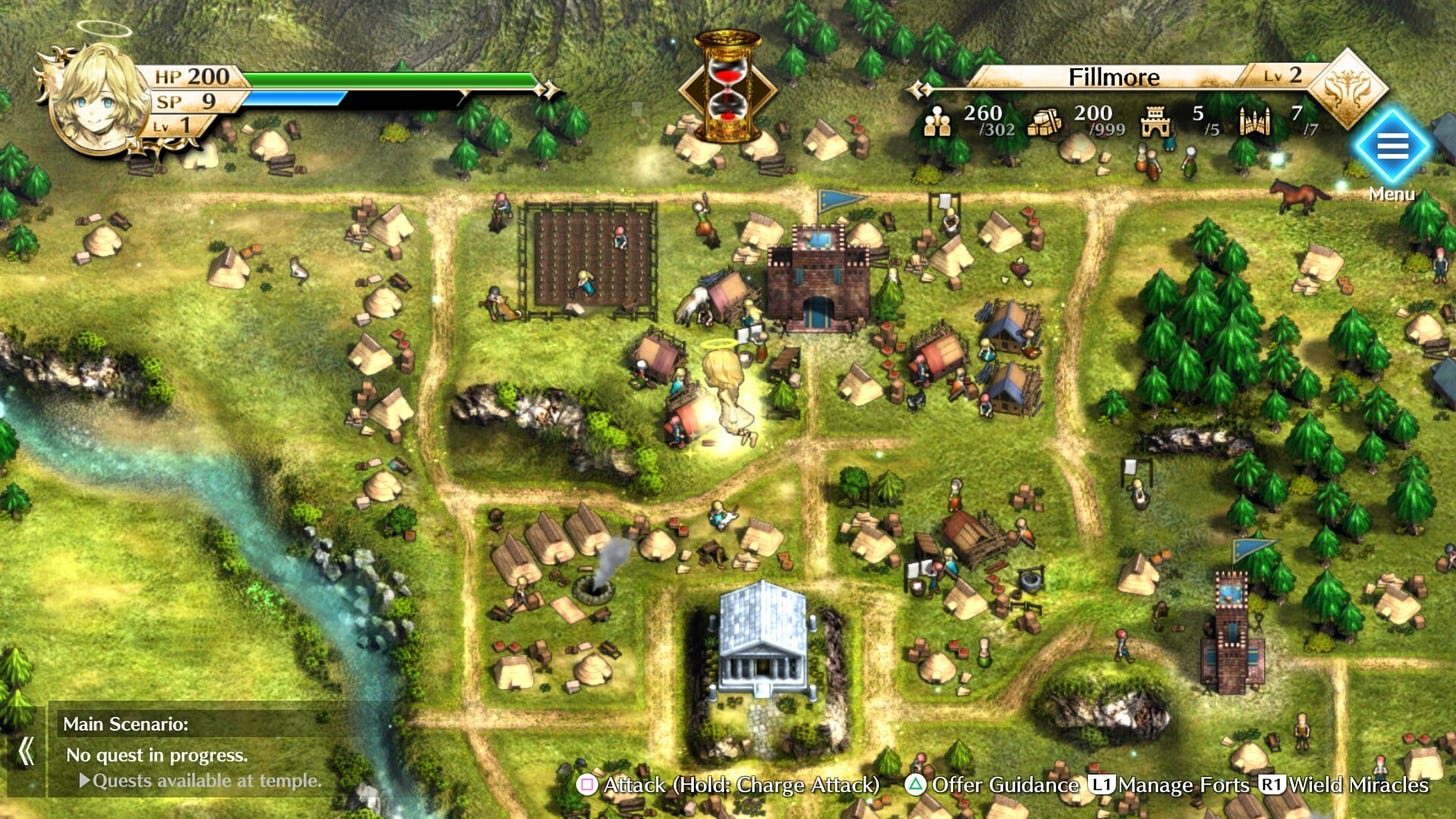
In addition, enemies now drop crystals when you defeat them, and these crystals feed into a meter that will enhance your performance. Collect enough to pass the first threshold, and your attack gets a 20 percent boost; reach the next one, and your magic gets the same. Fill the entire meter, and you get a 100 percent boost to both magic and attack, and a freebie resurrection that will not only keep you from using one of your extra lives, but will bring you back to life on the spot, in the middle of whatever it was you were doing when you were killed. This is, obviously, significant for the boss fights and not having to redo them from the start, but it can also be useful just if you slipped and fell into the ether while platforming when you didn’t have enough health points left to pay that fee. Considering you would straight-up lose a life for falling in a hole in the original, these are all welcome tweaks.
This new system might seem fun but kind of pointless on the game’s normal difficulty, since fully loading up on crystals makes your character feel like the avatar of a god that they are and can have you just going through the motions, but that’s because normal in Actraiser Renaissance feels like what would have been an easy mode in the original. If you are familiar with ActRaiser in general or just want to challenge yourself a bit, you should play on hard instead of normal. You can change the difficulty at any time if things are proving too easy or too tough, anyway, so feel free to experiment, or switch to hard for platforming sections only if that’s the kind of thrill you need to feel alive.
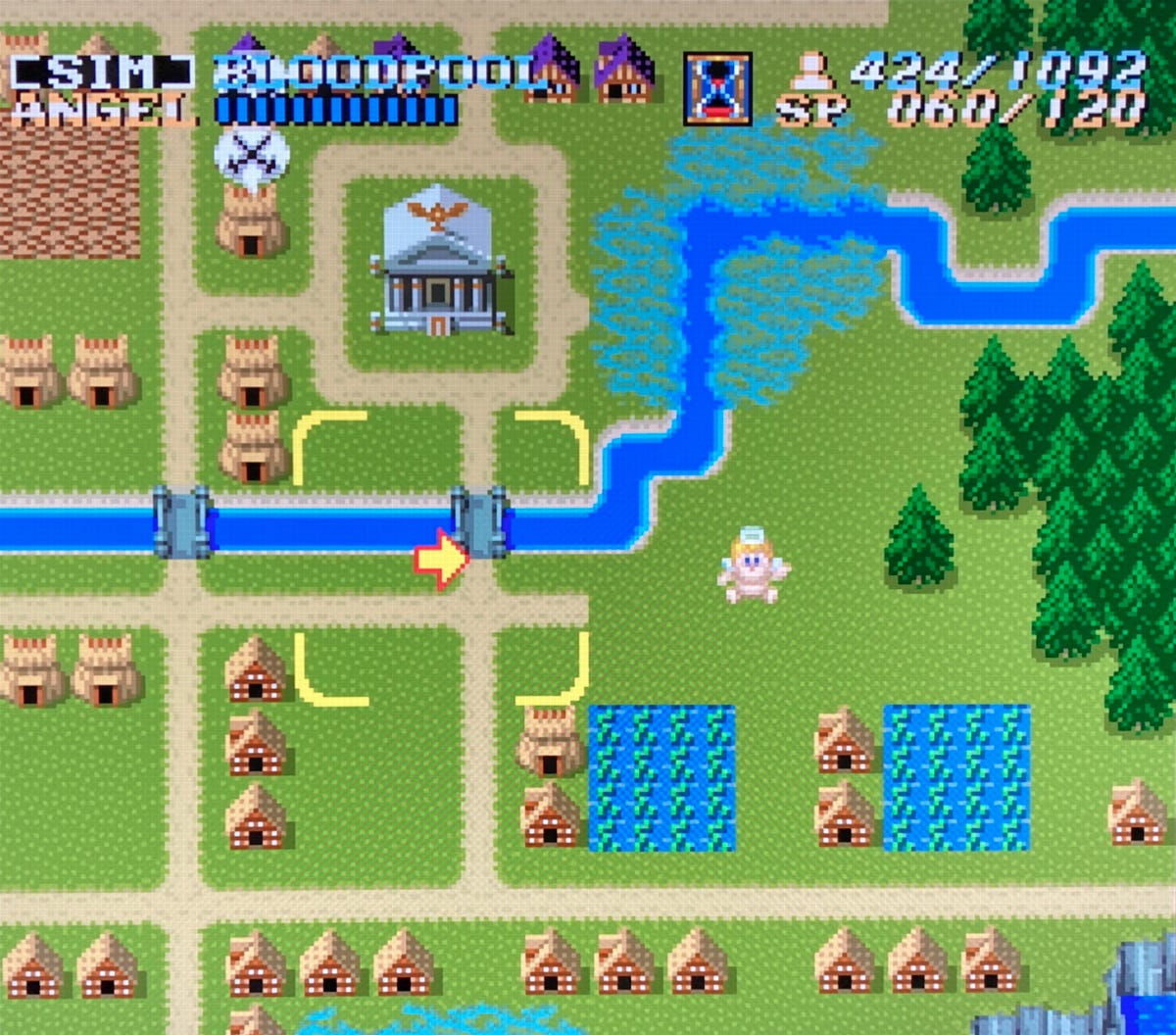
Bumping the difficulty up helps with another of the game’s new sections, as you now need to personally clear out the monster lairs yourself instead of letting the citizenry of each area automatically do so after you lead them there in the god-sim portions of the game. These are simple and repetitive on normal, but on hard, that limited time you have to complete the stage suddenly matters, as these stages are throwing boss-level enemies at you late, or simply trying to overwhelm you with projectiles and respawning foes. Sometimes both! It’s not as simple to just stand there and ignore everything that’s happening around you while you hack away at the enemy whose death will successfully complete the stage for you when you’re playing on hard.
So, the action stages are something of a wash. Harder to look at, unless you have a particular affinity for that style, but with superior gameplay. Their existence makes me wish that the original graphics could have been switched on, like is an option in remasters like Wonder Boy: The Dragon’s Trap, because combining the crystal collection stat boosts, scroll collection, and quality-of-life improvements with the original look of the game, but optimized for playing in HD, would have been superior to what we did get.
Luckily, the music did get this treatment: at any time, you can switch between the Renaissance orchestral arrangements of the original soundtrack and the original SNES versions. Did ActRaiser need fully orchestrated arrangements of its music? Not especially, not when Yuzo Koshiro was so successful in creating these compositions in the first place on the SNES’ hardware, but to say that these new arrangements aren’t welcome, anyway, would just be a lie. The reason the original songs sounded so good is that Koshiro and Quintet’s programmers figured out how to work beyond the limitations imposed by the SNES hardware, which restricted music samples to just 64kb. There are explanations out there more technical than what I can give you, but at least know this: Quintet figured out very early on in the SNES’ lifespan how to create a richer, fuller sound than should have been possible with these size limitations in place, and it’s why it’s perfectly reasonable for me to say the orchestral arrangements weren’t necessary, even if they are great. The original sound still holds up so well, and is at its best when Koshiro’s obvious reverence for John Williams’ Star Wars work is present.
I mean, listen to this, and try to tell me Koshiro wasn’t writing a love letter to Williams:
It’s perfect music for a god to be hearing while on their quest to rid the world of evil. The arrangement — also done by Koshiro, as were all of the new and modified tracks — is also spectacular to listen to, but I don’t blame you if you have a preference for the original:
Personally, I bounced back and forth between the new and old versions of the soundtrack as I played. Even the new songs on the soundtrack have SNES counterparts, as Koshiro made sure to program them with that hardware first, to ensure that they fit in with the older compositions. It’s one of the great video game soundtracks ever, now bigger and better, and it’s hard to argue against that.
What’s also bigger and better — though, easier to argue against that being fact — are the god-sim portions of Actraiser Renaissance. Don’t get me wrong, I love how quickly everything comes together in the original ActRaiser, and I do have some quibbles with the way Renaissance deployed changes to that formula. But overall, this feels like a stronger, deeper product now, one that made me understand why a remaster of a 30-year-old game was selling for $30 on the Playstation 4, Switch, and PC in 2021. Again, I don’t exactly trust Square’s decision-making when it comes to pricing out remasters: that I purchased this while it was still full price, unlike with every other Square remaster that I’ve ever picked up, should tell you something about how I feel about ActRaiser.
For one, you aren’t so much a god acting alone anymore in the fight against your dark counterpart, Tanzra. Now, you’ll find your own allies on Earth much like Tanzra has, and these people will become the champions that protect each region after you have moved on to help another one thrive. They have their own backstories and growth, and interact well with the people of these regions. Their presence is often so seamless that there was more than one occasion where I thought to myself, “Was this part of the original game and I just forgot?” Something so non-intrusive that I nearly Mandela Effected myself while playing? That’s a far better way to go about change than whatever it is Sonic Powered was trying to pull off with that action stage aura thing.
Where the changes were a little less welcome — though not entirely so — came in the more real-time strategy elements that were introduced. These tower-defense segments are fine in a vacuum — the enemy types and tower types are varied enough that Renaissance gets the mileage it needs out of them, and the ability to control and summon additional heroes to a region to help defend adds another layer of active strategy to the proceedings, too. However, there are just too many of them, and they start to wear on in a game that used to be exemplary for its brisk pacing alone. That you still have to deal with these tower defense segments even after clearing out all of the monster lairs, for no other reason than, “You have spent too much time in this region without having to go into tower defense mode,” is the worst offender of all. Let my people live in peace for a while, I’m just trying to trigger the bonus missions before moving on!
If there had been fewer of these segments, or even if there just were no longer any tower-defense bits after you cleared out the monster lairs, I’d feel differently about them. But because they just keep happening, in perpetuity, I didn’t bother earning 100 percent completion in every single region. Which is a shame, because, absent the infinite tower-defense spawns to contend with, I would have.
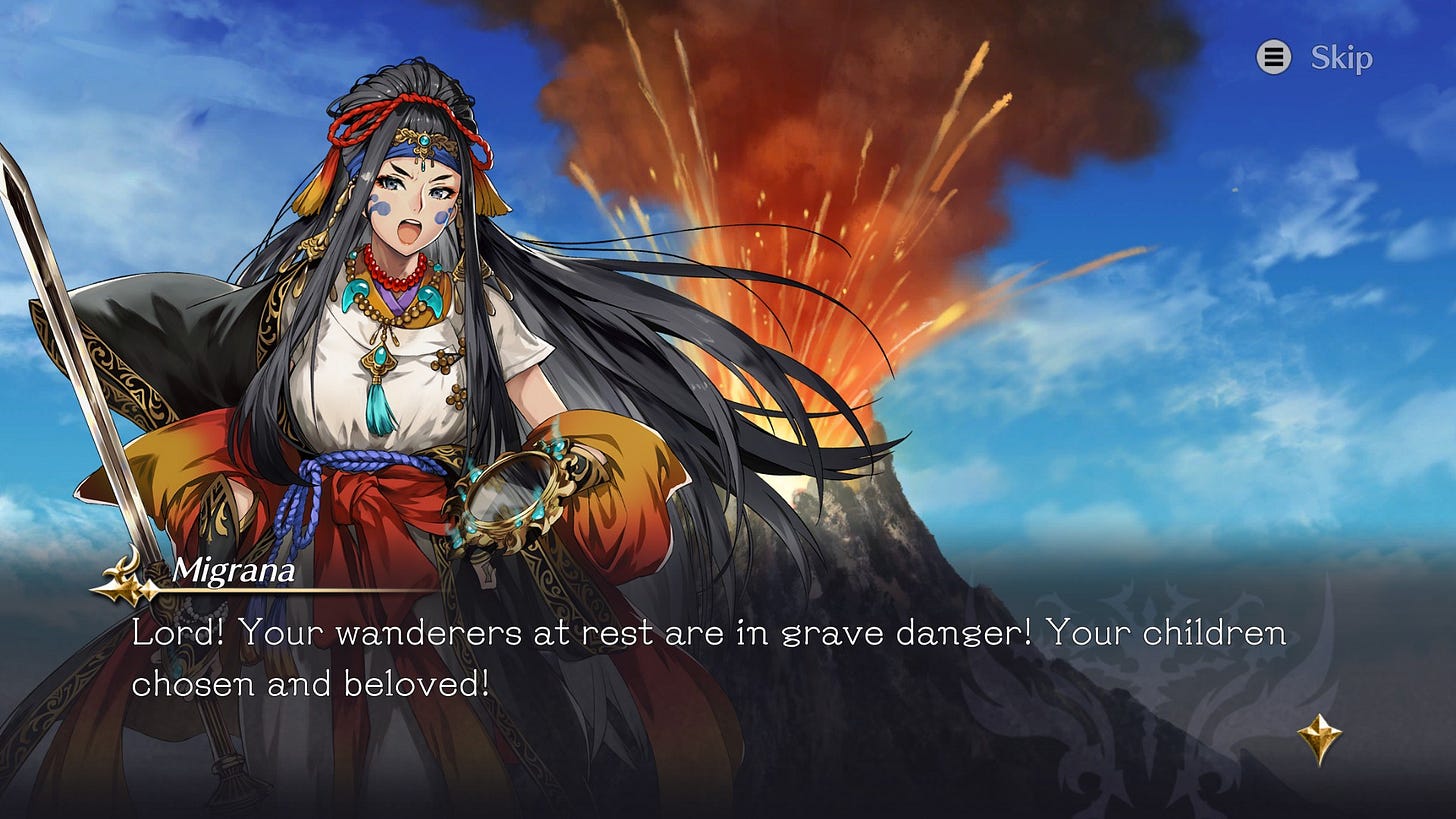
That being said, though, like with the graphical changes being a problem in the action stages, the tower-defense segments aren’t enough to drag things down, especially since the issue is just that there are too many of them. The graphics in the god-sim sections are legitimately improved from the original, with more detail and better animation, and the streamlining of the menus that take advantage of the additional buttons found on controllers in 2021 vs. controllers in 1990 helps keep everything moving in a way the original’s god-sim gameplay did not. Using miracles in the god-sim sections never bothered me much in the original, because the way to use them — open up a menu, listen to an explanation every single time, then use the miracle once — was the only way I knew. Now, though, when you simply open up a radial menu and use the miracle, going back to the old ways was a little harder. Especially when you consider that you can now do super versions of the miracles that use up more skill points, but will basically clear out a significant chunk of the region in the way you need instead of just a little box, too.
Since there are additional elements in Renaissance that require you destroy your civilization’s homes and workshops and farms so they can be cleared away and replaced with more efficient, significant technology, being able to blast one-third of a region with a single blast of lightning has its perks. Is it goofy that you need to destroy these homes for population optimization rather than just guiding people toward renovations? Yes, absolutely. That doesn’t diminish how much easier it is to destroy everything with the improvements made to the menus, though.
ActRaiser was a game that was much more than the sum of its two disparate parts, and that gave us one of the great video game soundtracks of its era — and frankly, beyond it — as well. Renaissance made some missteps in bringing this game back to the world, sure, but they can be overlooked because of the sheer greatness of what’s otherwise here. Is the remaster a necessary buy for fans of the original? I think there’s enough here to justify it, even if you, like I do, end up annoyed at certain additions — there’s a whole new region at the end, that seems subtly optimistic that there could be more Actraiser in the future. Hopefully, though, there is at least future support for this title from Square, maybe adding in an ability to switch between the classic SNES graphics and the modern-era ones, same as the music, because that would make for the definitive version of ActRaiser. Even if that version still had tower-defense segments popping up unwanted forever and ever, too.
Hey, little is perfect, not even ActRaiser.
This newsletter is free for anyone to read, but if you’d like to support my ability to continue writing, you can become a Patreon supporter, or donate to my Ko-fi to fund future game coverage at Retro XP.

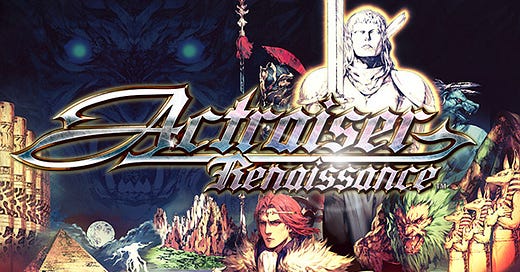


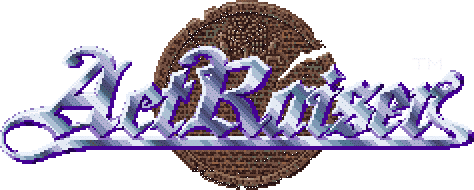
I seriously squealed audibly and threw up my hands when this game was announced on the Direct. I had just played through the original on the Wii virtual console the week prior and that hits something I think is important.
People really owe it to themselves to put the 2 or 3 hours it takes to complete the original game before playing this version because a fair amount of the fun I had with it was trying to anticipate how Square Enix would handle a given section (the aquatic dragon in Aitos for example). Seeing the tree monster in Fillmore Act 1 being put on its own screen as a miniboss was great also.
Hopefully this sells well enough that we get to see remasters of all the Enix properties - picture a modernized E.V.O. or Soul Blazer🤤